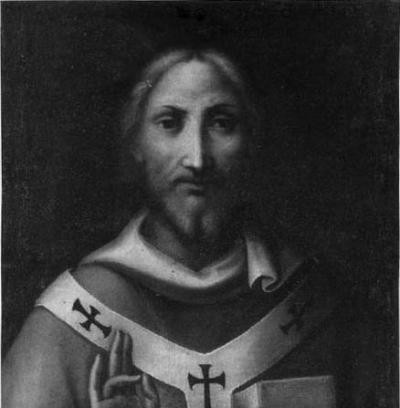
Saint of the Day December 19: St. Anastasius I
St. Anastasius I: The Life and Work of the Pope Who Defended Christian Orthodoxy
Name
Anastasio de Massimi
Title
Pope
Birth
4th century, Rome
Death
December 19, 401, Rome
Recurrence
19 December
Prayer
O Almighty and Eternal Lord, we beseech Your Immense Goodness to come to our aid so that, through the great merits of St. Anastasius, every fear, every dread, every anguish may be eradicated by His holy blessing; grant, O Lord, that the demons of terror may be put to flight and that all the evils and scourges caused by them may instantly cease, and that finally the Angels of Peace may faithfully guard us. Through Jesus Christ Our Lord. So be it.
Patron Saint of
Troia, Castel Sant’Elia
Roman Martyrology
In Rome in Pontian’s cemetery on the Via Portuense, deposition of St. Anastasius I, pope, a man rich in poverty and apostolic solicitude, who firmly opposed heretical doctrines.
The Saint and Mission
St. Anastasius I, who served as pope at the dawn of the fifth century, is a significant figure in Church history for his contribution to the Christian mission. His pontificate, though brief, was marked by decisions and actions that reflected a deep dedication to spreading and safeguarding the Christian faith.
One of the main manifestations of St. Anastasius I’s mission was his commitment to the fight against heresies. During his pontificate, the Church was confronted with different theological currents that threatened the unity of Christian doctrine. St. Anastasius devoted himself vigorously to the defense of orthodoxy, recognizing that clarity and purity of faith were essential for the spiritual well-being of the faithful and for the cohesion of the Church.
In addition, St. Anastasius promoted the Christian mission through his correspondence with other Church leaders, demonstrating his ability to guide and influence beyond the confines of his immediate Roman environment. His letters and teachings helped to strengthen communion among the different parts of the Church, emphasizing the importance of unity and collaboration in the Christian mission.
St. Anastasius was also known for his humble approach to papal ministry. His personal life was characterized by simplicity and devotion, qualities that made him a model of Christian service. This humility was a fundamental aspect of his mission as he embodied Christ’s teachings on service and putting others before self.
The life and ministry of St. Anastasius I illustrate how Christian mission can be accomplished through defense of the faith, support for the unity of the Church, and a personal example of humility and dedication. His pontificate reminds us that leadership in the Church is not only a matter of authority, but also of service, defense of the truth and commitment to the common good of the community of believers.
The Saint and Mercy
St. Anastasius I, Pope of the Catholic Church at the turn of the fourth and fifth centuries, is a figure whose life and pontificate deeply reflect the theme of Christian mercy. His ministry took place during a period of significant theological and social challenges, and his approach to these issues reveals an understanding of mercy as central to the life and mission of the Church.
Mercy in the pontificate of St. Anastasius I is primarily manifested in his commitment to defend orthodoxy and combat heresies. At a time when the Church was threatened by internal divisions, his work to safeguard the purity of Christian doctrine was crucial to maintaining the unity of the Church. This dedication to truth and theological clarity was an act of mercy, as it aimed to protect the faithful from confusion and error.
Moreover, St. Anastasius I demonstrated mercy through his pastoral care. As pope, he was responsible not only for theological guidance but also for the spiritual welfare of the faithful. His ministry was marked by a desire to guide Christians toward a deeper understanding of their faith and to encourage them to live according to Gospel principles.
St. Anastasius was also distinguished by his relationships with other leading figures in the Church of his time. His approach to leadership was characterized by constructive dialogue and a commitment to maintaining peace and harmony within the Christian community. This attitude of openness and collaboration is another example of his vision of mercy, which included an effort to build and maintain positive relationships among the various members of the body of Christ.
The life and ministry of St. Anastasius I show us that mercy is a crucial aspect of leadership in the Church. His example encourages us to consider how we can exercise mercy in our roles, both defending the truth of the faith and promoting unity and peace within the Christian community.
Hagiography
Pope St. Anastasius, a Roman, succeeded Pope St. Siricius (Nov. 26) on Nov. 27, 399, and died Dec. 19, 401, after a pontificate of only two years. Among his friends and admirers were St. Jerome (Sept. 30), St. Augustine (Aug. 28) and St. Paulinus of Nola (Jun. 22). St. Jerome considered him very holy, rich in his poverty, and praised his blameless life and apostolic zeal. Anastasius supported the elder Jerome in his controversy against Rufinus of Aquileia, a historian and translator. Jerome engaged for several years in writing an exact version of the Bible, based on study in the original languages in which it was written and on previous translations. He was deeply offended by the translation made by Rufinus of Aquileia of Origen’s De principiis, a controversial work from the early third century that proposed an allegorical rather than a literal interpretation of many biblical passages. Jerome, who had once written of Rufinus “he is inseparably bound to me by a brotherly love,” became indignant in defense of his culture.
The dispute between the two, who both led ascetic lives near Jerusalem, was long and…
